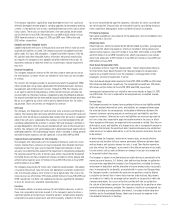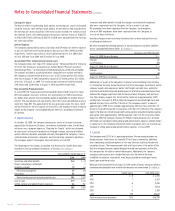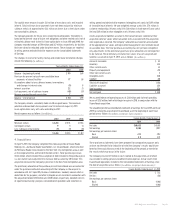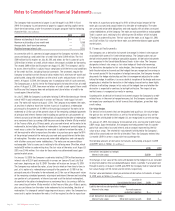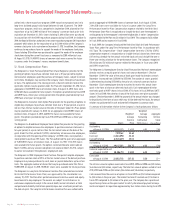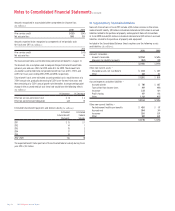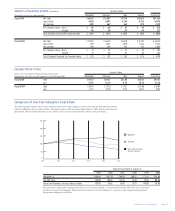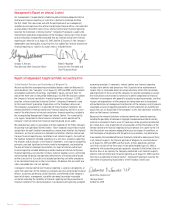Walgreens 2010 Annual Report Download - page 37
Download and view the complete annual report
Please find page 37 of the 2010 Walgreens annual report below. You can navigate through the pages in the report by either clicking on the pages listed below, or by using the keyword search tool below to find specific information within the annual report.
Gains and losses relating to the ineffectiveness of the Company’s derivative instru-
ments are recorded in interest expense on the Consolidated Statement of Earnings.
The amount recorded for the year ended August 31, 2010, was a $1 million gain.
In the prior fiscal year, the ineffective component was not material.
9. Fair Value Measurements
ASC Topic 820, Fair Value Measurements and Disclosures (formerly SFAS No. 157,
Fair Value Measurements), defines fair value as the price that would be received for
an asset or paid to transfer a liability in an orderly transaction between market
participants on the measurement date. In addition it establishes a fair value hierarchy
that prioritizes observable and unobservable inputs used to measure fair value into
three broad levels:
Level 1 — Quoted prices in active markets that are accessible at the measurement
date for identical assets and liabilities. The fair value hierarchy gives the
highest priority to Level 1 inputs.
Level 2 — Observable inputs other than quoted prices in active markets.
Level 3 — Unobservable inputs for which there is little or no market data available.
The fair value hierarchy gives the lowest priority to Level 3 inputs.
Assets and liabilities measured at fair value on a recurring basis were as follows
(In millions):
August 31, 2010 Level 1 Level 2 Level 3
Assets:
Interest rate swaps $ 44 — $ 44 —
August 31, 2009 Level 1 Level 2 Level 3
Liabilities:
Interest rate swaps $ 2 — $ 2 —
Interest rate swaps are valued using six-month LIBOR in arrears rates. See Note 8
for additional disclosure regarding financial instruments.
Assets measured at fair value on a non-recurring basis were as follows
(In millions):
August 31, 2009 Level 1 Level 2 Level 3
Assets:
Goodwill $ 3 — — $ 3
Goodwill for the Company’s Long-Term Care Pharmacy with a carrying value of
$19 million was written down to its implied fair value of $3 million. The impairment
resulted in a $16 million charge and added a $6 million deferred tax asset.
The determination of fair value was based on an asset sale agreement with
Omnicare which was signed on August 31, 2010. See Note 5 for further discussion
on the impairment.
The Company’s debt instruments are not reported at fair value in the Consolidated
Balance Sheets and as a result, it will continue to report under the guidance of
ASC Topic 825, Financial Instruments (formerly SFAS No. 107, Disclosures about
Fair Value of Financial Instruments), which requires the Company to disclose the
fair value of its debt in the footnotes.
10. Commitments and Contingencies
The Company is involved in legal proceedings, including those described below, and
is subject to investigations, inspections, audits, inquiries and similar actions by
governmental authorities, arising in the normal course of the Company’s business.
Although the outcome of these legal proceedings and other matters cannot be
forecast with certainty, management believes the final disposition of these matters
will not have a material adverse effect on the Company’s business or consolidated
financial position.
On April 16, 2008, the Plumbers and Steamfitters Local No. 7 Pension Fund filed a
putative class action suit against the Company and its former and current chief
executive officers in the United States District Court for the Northern District of
Illinois. The plaintiffs amended the complaint on October 16, 2008, which upon
the Company’s motion the District Court dismissed on September 24, 2009.
Subsequently, the plaintiffs moved for the District Court to reconsider the dismissal
and to allow plaintiffs leave to further amend the complaint. The District Court
granted plaintiffs’ motion on November 11, 2009. The second amended complaint
was then filed on behalf of purchasers of Company common stock during the period
between June 25, 2007 and October 1, 2007. As in the first amended complaint, the
second amended complaint charges the Company and its former and current chief
executive officers with violations of Section 10(b) of the Securities Exchange Act of
1934, claiming that the Company misled investors by failing to disclose (i) declining
rates of growth in generic drug sales and (ii) increasing selling, general and admin-
istrative expenses in the fourth quarter of 2007, which allegedly had a negative
impact on earnings. On February 1, 2010, the Company filed a motion to dismiss the
second amended complaint. On September 29, 2010, the District Court dismissed the
second amended complaint with prejudice. The plaintiffs have until October 29, 2010,
to appeal the District Court’s dismissal.
On August 31, 2009, a Walgreen Co. shareholder named Dan Himmel filed a lawsuit,
purportedly on the Company’s behalf, against several current and former officers
and directors (each, an “Individual Defendant”). The case is captioned Himmel v.
Wasson, et. al. and was filed in the Circuit Court of Lake County, Illinois. The allega-
tions in the lawsuit are similar to the securities fraud lawsuit described above.
Himmel alleges that the Company’s management: (i) knew, or was reckless in not
knowing, that selling, general and administrative expenses in the fourth quarter of
2007 were too high, in light of decreased profits from generic drug sales; (ii) knew,
or was reckless in not knowing, that the Company would not realize gross profits
near what many Wall Street analysts were predicting; and (iii) the directors and officers
had a duty both to prevent the drop in gross profits and to disclose the expected drop
to the public and failed to do either. The Company’s investigation to date suggests
that the allegations are without merit, and that the Individual Defendants acted in
good faith, exercised prudent business judgment and acted in a manner that they
reasonably believed to be in the Company’s best interests during the period at issue.
The Company intends to vigorously contest the allegations. The Individual
Defendants’ time to file a responsive pleading to the complaint was extended by
agreement until 30 days after the District Court in the Plumbers case rules on the
pending motion to dismiss, which ruling was issued on September 29, 2010.
The Company guarantees a credit agreement on behalf of SureScripts-RxHub, LLC,
which provides electronic prescription data services. This credit agreement, for
which SureScripts-RxHub, LLC is primarily liable, has an expiration date of June 30,
2011. The liability was $10 million at August 31, 2010 and 2009. The maximum amount
of future payments that could be required under the guaranty is $25 million, of which
$13 million may be recoverable from another guarantor. In addition, under certain
circumstances the Company may be required to provide an additional guarantee of
up to $10 million, of which $8 million may be recoverable from other guarantors.
This guarantee arose as a result of a business decision between parties to ensure
that the operations of SureScripts-RxHub, LLC would have additional support to
access financing. Should SureScripts-RxHub, LLC default or become unable to pay
its debts, the Company would be required to fulfill our portion of this guarantee.
11. Capital Stock
On October 14, 2009, the Board of Directors approved a long-term capital policy.
The Company’s long-term capital policy is to maintain a strong balance sheet and
financial flexibility; reinvest in its core strategies; invest in strategic opportunities
that reinforce its core strategies and meet return requirements; and return surplus
cash flow to shareholders in the form of dividends and share repurchases over the
long term. In connection with the Company’s capital policy, its Board of Directors
2010 Walgreens Annual Report Page 35






